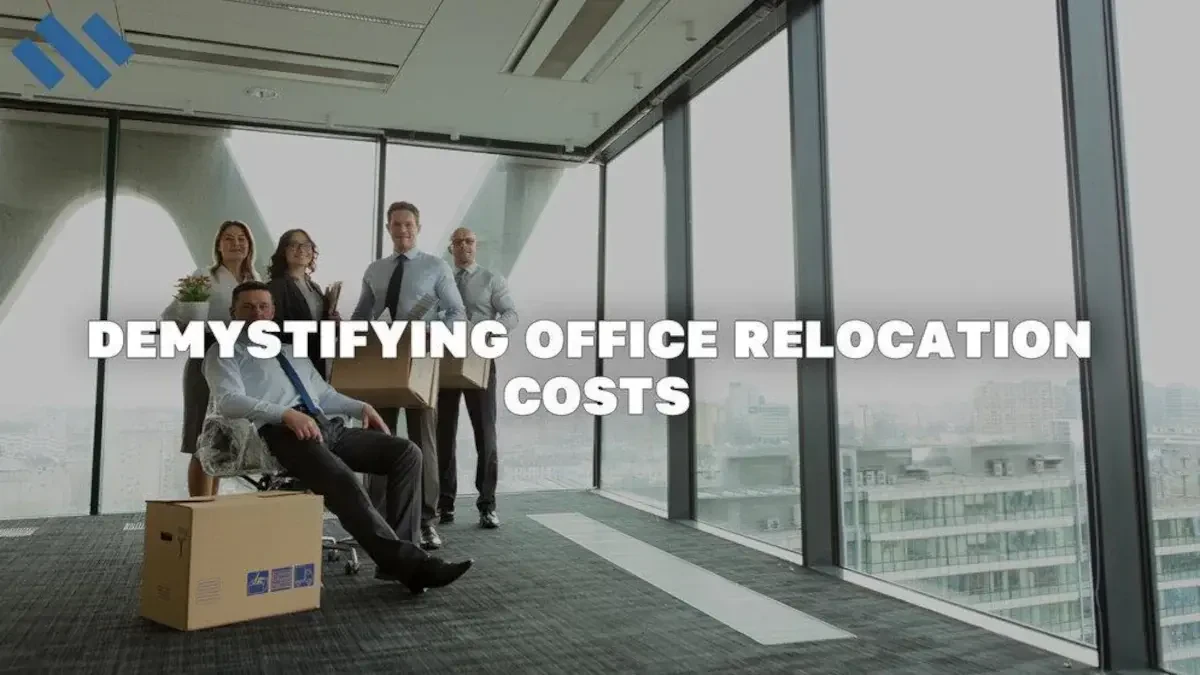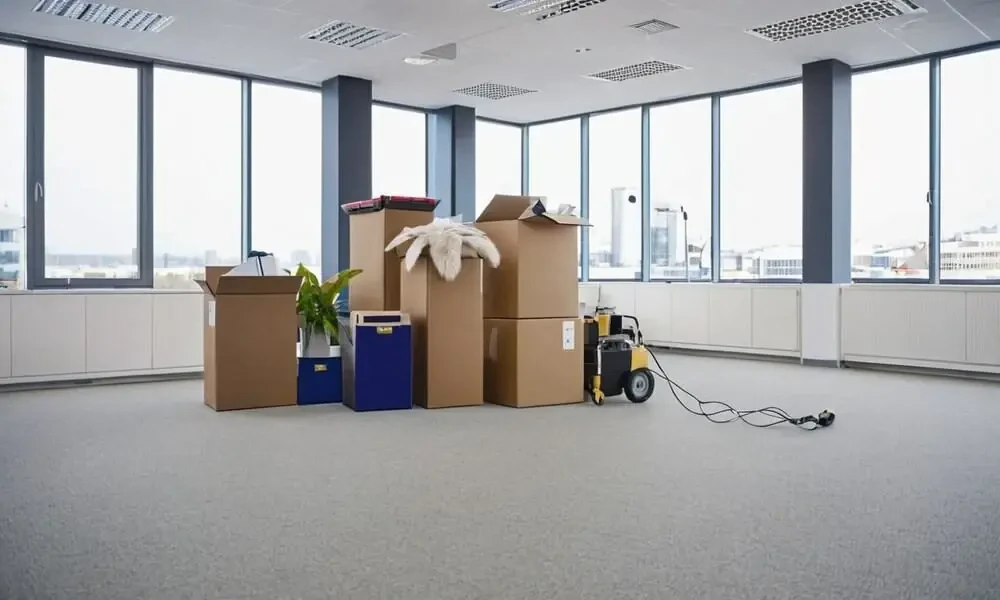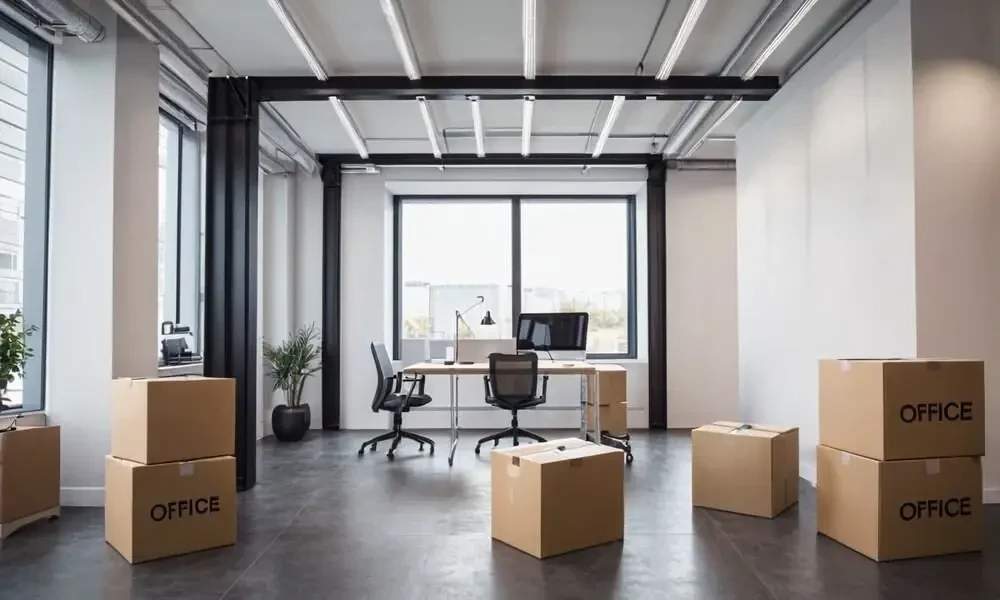Published by Chris Townsend
Last updated Jun, 07 2025

Relocating a business is a massive undertaking and can be seen as a blessing and a curse. The first thing to remember is that office relocation costs must be calculated before planning to move. While the evolution of your business is exciting, the physical act of moving all the furniture, computers, file cabinets, copy machines, and everything else in the facility can be very daunting. Not to mention, in addition to coordinating the actual move, you also have to make sure that your employees are happy throughout the process. Fortunately, with meticulous planning and a reliable shifting company, your office relocation can be smooth and seamless, regardless of the size and scope.
Whether your business is expanding, you desire a better location, or you simply want to upgrade your office space, there are a number of relocation costs to consider. So, if you’re wondering “What is the average cost of moving office?”, there is much to contemplate besides the rent for your new office space. After all, moving expenses can be expensive, and it’s important to understand the costs involved so you can budget accordingly.

Why should you consider relocating your office?
Relocating is a significant decision that should be carefully evaluated based on your business's unique needs and circumstances. Here are some reasons why you might consider relocating your office:
- Access to Talent: Shifting to a location with a strong talent pool in your industry can provide access to skilled employees, allowing you to recruit and retain top talent.
- Market Access: Relocating to a more strategic location can give you better access to your target market, clients, and partners, potentially boosting your business growth.
- Cost Savings: Moving to a region with lower operating costs, including rent, taxes, and utilities, can help reduce overhead expenses and increase your profitability.
- Expansion Opportunities: If your current space is limiting your expansion plans, relocating to a larger space or a more accommodating environment can support your business's growth goals.
- Improved Infrastructure: Relocating to an area with better infrastructure, transportation links, and amenities can enhance your employees' quality of life and streamline business operations.
- Networking and Collaboration: Being located in a hub or business district can provide opportunities for networking, collaboration, and potential partnerships with other businesses in your industry.
- Rebranding and Image: Moving to a new location can allow you to rebrand your business and project a fresh image to clients, employees, and stakeholders.
- Better Facilities: If your current office lacks modern facilities, shifting to a new space with updated technology, amenities, and layouts can enhance productivity and employee satisfaction.
- Strategic Alignment: Relocating your office to a location that aligns with your business strategy, values, and long-term goals can position your company for success.
- Tax Incentives: Some regions offer tax incentives, grants, or other economic benefits to attract businesses. Relocating to such areas could provide financial advantages.
- Diversification: If your current location is susceptible to specific risks, such as natural disasters, relocating to a more stable region can mitigate these risks.
- Lifestyle Considerations: If the work-life balance of your employees is important, moving to an area with a more desirable lifestyle can help attract and retain talent.
While there are potential benefits to relocating your office, it's important to conduct thorough research and consider the potential challenges as well. An office move can be disruptive and costly, and it's essential to assess whether the benefits outweigh the drawbacks for your specific situation. Careful planning, consultation with stakeholders, and a comprehensive analysis of costs and benefits are crucial before making a decision.

Estimates Of Shifting
The actual cost of moving your office may be the most apparent factor to consider, but when it comes to relocating a business, the cost is crucial. Working with a professional hauling company will help you prepare for your office move, carefully pack up your space, and get everything moved into your new office safely, efficiently, and on time. Professional movers can be particularly helpful for relocating heavy pieces of modular furniture and costly equipment.
Generally speaking, the average cost of hiring a moving service to relocate your office is between $750 and $4,500. However, the actual price that you pay will vary based on square footage, whether or not you opt for packing services, and a number of other factors.
What Impacts the Expense of Office Relocating?
Obviously, the size of your office building and the number of employees will have the biggest impact on the cost of shifting office. Aside from these factors, there are several other variables at play. Since each business is unique, it can be difficult to determine approximate moving costs, and there isn’t a one-size-fits-all answer.
The best way to properly prepare yourself and your business for an upcoming move is to obtain an estimate from your moving company of choice. To do this, you’ll want to make sure that you are transparent with your moving company and give them as much information regarding your office relocation as possible. Before your moving company can provide you with a quote, they will require an inventory list of all the materials that need to be moved.
With that said, follow the tips outlined below to ensure that you receive the most accurate quote possible from your moving company:
- Do a walkthrough of your office facility. When you’re creating the inventory list, it’s important that you don’t forget to include the common areas, such as restrooms, breakrooms, and the lobby. While this may sound like a no-brainer, it’s very common to only focus on offices, cubicles, and desks.
- Carefully examine all your office furniture. Are there items that need to be disassembled and then reassembled in your new office? Most companies will do this for you, but they’ll need to know upfront so they can allocate the time and necessary tools and equipment. For best results, request that your shipping company have a representative come out to your facility before the move.
- Consider your employee’s working areas. Have your employees handle the cleaning and boxing up of their own spaces. They should be responsible for organizing their personal documents, files, and effects prior to the move. Even if your company has an IT Department, enlist their help to ensure that all the technology is safely disconnected and reconnected at your new office.
- Storage solutions. It’s very common for businesses to need storage a couple of weeks before moving. Whether your new facility isn’t fully ready to be moved into or you’re moving one department at a time, you may need some offsite temporary storage. The best professional companies also offer storage as one of their many office moving services, and this service can be factored into the final cost of your relocation.
Technology Related Office Relocation Expenditures
Depending on the type of business you have, relocating your current office to a new location will most likely involve having to relocate several computers and another tech. This can add to the overall accounting for office relocation costs. Costs can vary based on factors like your internet provider, what providers are available in your new office, your specific location, and how many employees you have. Your move may also require you to purchase new equipment, like phones, wireless access points, servers, and more.
Regardless, setting up your internet services and the equipment you need to operate your business as quickly and efficiently as possible is crucial.
Build-Out Expenses
Unless you’ve chosen a new office location that is already built out based on an approved plan, you’re most likely going to have to make some changes to the space in order to accommodate your business’ needs. These changes may be as simple as swapping out the carpet or purchasing new window treatments, or as complicated as knocking down walls or building shelving.
If you’re renting the office, your landlord may issue some tenant improvement funds to make enhancements to the space. Though, you’ll still probably have to pay out of pocket for some changes.

How can I calculate office relocation charges?
Calculating office relocation costs can be a complex process, as it involves various factors such as distance, size of the office, type of equipment, labor, and additional services required. Here's a step-by-step guide to help you estimate your office relocation costs:
- Inventory and Assessment: Create a detailed inventory of all items in your current office, including furniture, equipment, electronics, and other assets. Assess the condition of each item to determine if any repairs, disassembly, or special handling are needed.
- Determine the New Location: Identify the new location for your office. Consider factors such as distance, accessibility, lease terms, and potential renovations or modifications needed.
- Gather Quotes: Contact several professional office moving companies to get quotes. Provide them with accurate information about your current and new locations, the size of the office, and any special requirements. Ask for detailed breakdowns of their estimates.
- Types of Costs: Break down the costs into categories, including:
- Packing Materials: Boxes, packing tape, bubble wrap, and other packing supplies.
- Labor Costs: Cost of professional movers or your own staff's time if you're doing a DIY move.
- Transportation: Cost of trucks or vehicles to transport your items.
- Specialized Equipment: Costs for heavy equipment, cranes, or special tools required for moving certain items.
- Insurance: Consider insurance coverage to protect your items during the move.
- Temporary Storage: If you need to store items temporarily before moving to the new office.
- Additional Services: Setting up equipment, IT services, disassembly/reassembly of furniture, etc.
- Calculate Labor Costs: If you're hiring a relocating company, they will often charge by the hour and the number of movers. Estimate the time required for packing, loading, transportation, unloading, and unpacking. If you're using your team, consider their hourly wages and factor in the time they'll spend on moving tasks.
- Transportation Costs: Depending on the distance and volume of items, transportation costs can vary. Some companies charge by distance, while others may charge a flat rate.
- Additional Services: If you require services such as IT setup, furniture assembly, or special handling of delicate items, inquire about the associated costs.
- Miscellaneous Costs: Don't forget to account for incidental costs such as parking fees, tolls, permits, and any other move cost.
- Contingency Fund: It's wise to set aside contingency money to cover unexpected expenses that might arise during the move.
- Compare and Decide: Once you have quotes from different hauling companies and a clear breakdown of costs, compare them to choose the option that aligns with your budget and needs.
Remember that while getting estimates is essential, you should also consider the reputation and reliability of the moving companies. It's recommended to work with reputable and experienced professionals to ensure a smooth and successful office relocation.

What to consider when repositioning the office?
Shifting an office involves careful planning and consideration to ensure a smooth transition. Here are key factors to consider when moving your office:
- Location and Accessibility: Choose a new location that suits your business needs, is accessible to employees and clients, and aligns with your company's image. Consider factors like proximity to public transportation, parking availability, and local amenities.
- Budget and Costs: Determine your budget for the move, including expenses like hiring movers, packing materials, new furniture or equipment, lease costs for the new space, and potential renovations or modifications.
- Timeline: Plan the move well in advance to allow sufficient time for packing, organizing logistics, notifying stakeholders, and ensuring a smooth transition. Create a detailed timeline and schedule to keep the process on track.
- Space Planning and Layout: Design the layout of the new space, considering factors like the arrangement of workstations, offices, meeting rooms, and common areas, for example. Ensure optimal space utilization and functionality.
- Technology and IT Infrastructure: Coordinate the transfer of IT equipment, phones, internet connections, and data systems to minimize downtime. Ensure that the new office space is wired and equipped for your technology needs.
- Communication and Notification: Notify employees, clients, vendors, and other stakeholders about the upcoming move. Clearly communicate the new address, moving date, and any changes to business operations.
- Furniture and Equipment: Determine what furniture and equipment will be moved to the new office and what might need replacement or upgrades. Consider the ergonomic needs of employees and the overall design aesthetic.
- Packing and Labeling: Plan how items will be packed, labeled, and organized for the move. Clearly label boxes and items to make unpacking and setting up the new office easier.
- Security and Data Protection: Ensure that sensitive information and data are securely transferred. Implement security measures for physical and digital assets during the move.
- Vendor Coordination: If you rely on external vendors or service providers (cleaning services, utility providers, etc.), inform them of the move and coordinate the necessary changes.
- Legal and Regulatory Considerations: Review lease agreements, contracts, and any legal obligations related to the move. Make sure you comply with local zoning and licensing regulations.
- Employee Involvement: Involve employees in the planning process to gather their input and address any concerns they might have. Keep them informed and engaged throughout the transition.
- Change of Address and Branding: Update your business's address on all official documents, websites, marketing materials, and directories. Ensure your branding is updated to reflect the new location.
- Testing and Readiness: Test equipment, IT systems, and communication tools in the new office before the actual move. This will help identify and resolve any potential issues in advance.
- Emergency Preparedness: Have a plan in place for dealing with emergencies during the move, such as power outages or equipment failures.
- Post-Move Evaluation: After the move, assess how smoothly the transition went and gather feedback from employees. Identify any areas that need improvement for future reference.
By considering these factors and planning ahead, you can minimize disruptions and ensure a successful office relocation process.

Making decisions on office shipping
Relevant Statistics
- On average, relocations in major cities cost between $15,000 and $50,000.
- Approximately 80% of relocation costs are attributed to IT infrastructure setup and data migration.
- Research shows that companies spend around 10-20% of their annual budget on office relocations.
- The cost of hiring professional movers ranges from $5 to $8 per square foot.
- Studies indicate that companies typically experience a 20-30% increase in productivity after an office relocation.
General Facts
- Relocation costs refer to the expenses incurred when moving an office from one location to another.
- These costs can include packing and transportation of furniture, equipment, and supplies.
- Additional expenses may arise from hiring professional movers or specialized services for handling sensitive equipment or documents.
- Factors that affect costs include the distance between locations, the size of the office, and the complexity of the move.
- It is important for businesses to carefully budget and plan for relocation costs to minimize disruptions and ensure a smooth transition.

How Does This Work?
In most cases, businesses will select a manager to take care of all the logistics of an office move. This individual also assumes responsibility for all the potential issues that could arise during the relocation. Then, the company you hire will appoint a representative to work directly with this manager to iron out all the details. That said, here is a brief snapshot of what a typical office move looks like:
- Requesting Estimates. Every move, whether it’s a residential or office move, begins by requesting a quote. Start by reaching out to a couple of reputable moving companies to discuss your needs and obtain a free, no-obligation quote for the required services.
- The Walkthrough. After the initial contact, the company will usually schedule a walkthrough of your current and new office facilities. During this walkthrough, the commercial moving cost estimator will inspect both locations to assess any potential challenges and come up with an ideal action plan that minimizes disruption.
- The Packing Process. Depending on your company’s individual needs, either your employees or the movers will handle the packing of workstations and office equipment. Generally speaking, companies typically prefer to have the employees take care of packing up their desks. Then, on a moving day, the movers will carefully prepare and pack up all the cubicles, desks, furniture, and equipment to be safely transported to the new office.
- Labeling. Your professional movers will place thorough labels on all the boxes to ensure that everything is placed in the correct location in your new office. This makes it much easier to sort and organize everything once it’s delivered.
- The Physical Move. During this stage, the hauling company will physically transport all of the equipment, furniture, and boxes. To limit interruptions, most moves are completed after business hours – either overnight or on a weekend.
- Placement & Unpacking. Once everything arrives at the new office space, the movers will handle everything from the reassembly of workstations to placing boxes in the designated rooms.
Timing is absolutely critical to help reduce any disruptions to your business. For best results, you should start communicating with your moving company of choice at least six months in advance of your move. This will guarantee that there is plenty of time to properly strategize, arrange, and execute all the logistics.
Look no further than Three Movers for all your office moving needs. For more information about preparing for and planning your upcoming office relocation, and to receive your free, no-obligation estimate, contact Three Movers today!

Frequently Asked Questions
It will take a minimum of three months for a small office to prepare to move and six to eight months to relocate from a medium to a large workplace. Before that, draw a floorplan of your new office space, so there's no confusion about the details when you arrive.
Relocation allowance packages can vary from $2,000 to $100,000. What services and the budget you decide to pay depends on you and your company and its employee relocation package. However, remember that the more you are willing to give, the harder it may be for a candidate to refuse your offer when negotiating moving expenses!
Generally, a relocation package covers the costs of moving and storing furnishings, household goods, assistance with selling an existing home, costs incurred with temporary housing, and all travel costs.
The cost of hiring professional movers can vary widely depending on several factors. These factors include the distance of the move, the size of your office, the number of items to be moved, the level of service you require, the time of year, and the location. It's important to get quotes from multiple moving companies to get an accurate estimate for your specific situation. However, I can provide you with a general range of costs to give you an idea:
Local Moves (within the same city or nearby): For a small office with fewer items, a local move might cost anywhere from $200 to $2,000. Larger offices with more items could cost between $1,000 and $5,000 or more.
Long-Distance Moves (across state lines or over a significant distance): Long-distance moves are typically priced based on the weight of your items and the distance. On average, you might expect to pay around $2,000 to $5,000 for a small office and up to $10,000 or more for a larger office.
Additional Services: If you require additional services such as packing, unpacking, specialty item handling, or furniture assembly/disassembly, these services will add to the overall cost.
Seasonal Variations: Moving costs can be affected by the time of year. Summer months are often peak moving season and can be more expensive compared to other times of the year.
Insurance: It's wise to consider insurance coverage for your items during the move. This might add an extra percentage to the overall cost. But it will offer you protection in the case of loss or damage.
Movers' Rates: Movers' rates can vary based on the reputation of the company, their experience, and the quality of service they provide. Cheaper options might not always provide the best service or reliability.
Additional Fees: Some moving companies might charge additional fees for factors like stairs, elevators, long carrying distances, or if your office is not easily accessible.
Hourly vs. Flat Rate: Some movers charge an hourly rate, while others offer a flat rate. Be sure to clarify how the company charges for their services.
Size of the Crew: The number of movers required can affect the cost. More movers can expedite the process but may also increase the overall cost.
Remember that these figures are just rough estimates and can vary significantly depending on your specific circumstances. It's crucial to request quotes from multiple reputable moving companies and provide them with detailed information about your office and the move to get accurate pricing. Additionally, be sure to read reviews and do your research to choose a reliable and reputable moving company that fits within your budget.
Moving the contents of a 1,500-square foot office costs $750-$4,500, depending on the amount of materials moved. A legal or accounting office with many files or an office with modular units that need to be unassembled runs at the higher end of the scale. A virtual paperless company with little furniture will cost less.
Packing and moving a 3,000-square foot office averages $1,500 to $9,000 for spaces with large amounts of files and furniture.
Moving a large, 10,000 square-foot office starts around $5,000 and runs up to $30,000 for companies with numerous employees and workstations that need to be moved.
Office moves based on the truckload average $500-$1,500 per load depending on the time it takes to load, the difficulty and the number of movers. Average truck rates are around $100 per hour per truck with three movers or $150 per hour for a two truck with five movers.
An office move based on the number of employees costs $50-$250 or more per employee.
Businesses may be able to deduct certain moving expenses on their tax returns, but there have been changes to tax laws, so it's important to consult a tax professional or the most up-to-date tax regulations for your jurisdiction. Generally, here are some points to consider regarding deductibility of moving expenses for a company:
Qualifying Criteria: In the past, businesses could deduct moving expenses if the move was closely related to the start of business operations or a change in the location of the business. The move needed to meet both a distance and time test, with the new location being a certain distance away from the old location and the employee working full-time for a specific period after the move (usually around 39 weeks within the first 12 months after the move).
Qualified Expenses: Qualified moving expenses generally included costs directly related to the move of the business, such as transportation, packing, storage, and lodging during the move.
Non-Deductible Expenses: Expenses that were not related to the move itself, such as expenses incurred in the sale of a previous home, were typically not deductible.
Tax Reform Changes: The Tax Cuts and Jobs Act (TCJA) that went into effect in 2018 made significant changes to the deductibility of moving expenses for individuals, including employees, but some of these changes also affected businesses. Under TCJA, most individuals, except for active-duty military members, were no longer able to deduct moving expenses. This could have had an impact on businesses that provided reimbursements for employee moves.
Consult a Tax Professional: Given the complexity of tax laws and the potential changes that may have occurred since my last update, it's strongly advised to consult a tax professional or accountant who is familiar with the most current regulations and can provide guidance specific to your business and jurisdiction.
Keep in mind that tax laws can vary depending on your country and region, and they are subject to change over time. To get accurate and up-to-date information on what moving expenses are deductible for your company, it's best to seek advice from a qualified tax professional who can provide guidance based on the most current laws and regulations applicable to your situation.
Choosing the right moving company for your office relocation is a crucial decision to ensure a smooth and successful move. Here are some steps to help you choose the best moving company for your needs:
Research and Gather Recommendations: Start by researching local moving companies. You can ask for recommendations from colleagues, friends, or other businesses that have recently moved. Online review platforms and business directories can also provide insights into the reputation and reliability of moving companies in your area.
Check Credentials and Licensing: Verify that the moving companies you're considering are properly licensed and insured. Check if they have the necessary permits and are compliant with local and state regulations. This helps ensure that you're working with a legitimate and reputable company.
Get Multiple Quotes: Reach out to several moving companies to get quotes for your office relocation. Ask them to provide detailed estimates that outline the costs for various services, including packing, transportation, labor, and any additional services you require.
On-Site Inspection: A reliable moving company should be willing to conduct an on-site inspection of your office to assess the size, volume, and complexity of the move. This allows them to provide a more accurate and tailored estimate.
Check Experience and Expertise: Inquire about the moving company's experience with office relocations. Ask how many office moves they have successfully handled and if they have experience with moves similar to yours in terms of size and requirements.
Read Reviews and Testimonials: Look for reviews and testimonials from previous clients. This can provide valuable insights into the quality of their service, professionalism, and reliability. Pay attention to any recurring positive or negative themes.
Ask About Equipment and Techniques: Inquire about the equipment and techniques the company uses for packing, handling, and transporting office items. Modern equipment and proper techniques can help ensure the safety of your belongings during the move.
Discuss Insurance Coverage: Clarify the insurance coverage the moving company provides for your items during the move. Consider whether you need additional coverage to protect valuable or sensitive items.
Check Contract and Terms: Carefully review the contract and terms provided by the moving companies. Ensure that all services, costs, and expectations are clearly outlined in the contract before you sign.
Communication and Customer Service: Assess the company's communication skills and responsiveness. A reliable moving company should be easy to reach and willing to address your questions and concerns promptly.
Visit Their Office (Optional): If possible, consider visiting the moving company's office to get a sense of their professionalism and operations. This can help you gauge their level of organization and commitment.
Trust Your Gut: Listen to your instincts. If something doesn't feel right or you're uncomfortable with the communication, consider other options.


